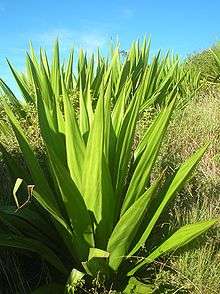Furcraea foetida
Furcraea foetida (Giant Cabuya, Green-aloe or Mauritius-hemp) is a species of flowering plant native to the Caribbean and northern South America. It is widely cultivated and reportedly naturalized in many places (India, parts of Africa, Portugal, Australia, Thailand, Florida, and many oceanic islands)[1][2][3][4][5][6][7][8][9][10][11][12][13][14][15][16][17][18][19][20][21][22][23]
| Furcraea foetida | |
|---|---|
 | |
| Scientific classification | |
| Kingdom: | Plantae |
| Clade: | Tracheophytes |
| Clade: | Angiosperms |
| Clade: | Monocots |
| Order: | Asparagales |
| Family: | Asparagaceae |
| Subfamily: | Agavoideae |
| Genus: | Furcraea |
| Species: | F. foetida |
| Binomial name | |
| Furcraea foetida | |
| Synonyms[1] | |
| |
Description

Furcraea foetida is an evergreen perennial subshrub, stemless or with a short stem up to 1 m tall. The leaves are sword-shaped, 1-1.8 m long and 10–15 cm broad at their widest point, narrowing to 6–7 cm broad at the leaf base, and to a sharp spine tip at the apex; the margins are entire or with a few hooked spines. The flowers are greenish to creamy white, 4 cm long, and strongly scented; they are produced on a large inflorescence up to 7.5 m tall.[24]
- Cultivation
The plant is cultivated in subtropical and tropical regions for products and as an ornamental plant for gardens. Its leaves are used to produce a natural fiber similar to sisal.
References
- Kew World Checklist of Selected Plant Families
- Akoègninou, A., van der Burg, W.J. & van der Maesen, L.J.G. (eds.) (2006). Flore Analytique du Bénin: 1-1034. Backhuys Publishers.
- Hokche, O., Berry, P.E. & Huber, O. (eds.) (2008). Nuevo Catálogo de la Flora Vascular de Venezuela: 1-859. Fundación Instituto Botánico de Venezuela.
- Figueiredo, E. & Smith, G.F. (2008). Plants of Angola. Strelitzia 22: 1-279. National Botanical Institute, Pretoria.
- Pandey, R.P. & Dilwakar, P.G. (2008). An integrated check-list flora of Andaman and Nicobar islands, India. Journal of Economic and Taxonomic Botany 32: 403-500.
- Vikraman, R.R., Pandurangan, A.G. & Thulasidas, G. (2008). A study on the garden escaped exotics of Thiruvananthapuram district, Kerala. Journal of Economic and Taxonomic Botany 32: 765-781.
- Acevedo-Rodríguez, P. & Strong, M.T. (2012). Catalogue of seed plants of the West Indies. Smithsonian Contributions to Botany 98: 1-1192.
- Sykes, W.R. (1970). Contributions to the Flora of Niue: 1-321. Botany Division, Sept. of Sci. and Industrial Research, Christchurch.
- Lebrun, J.P. (1973). Énumération des plantes vasculaires du Sénégal: 1-209. Maisons Alfort: Institut d'élevage et de médecine vétérinaire des pays tropicaux.
- Bosser, J. & al. (eds.) (1978). Flore des Mascareignes 177-188: IRD Éditions, MSIRI, RBG-Kew, Paris.
- Smith, A.C. (1979). Flora Vitiensis Nova. A new flora for Fiji (Spermatophytes only) 1: 1-495. Pacific Tropical Botanical Garden, Lawai.
- Healey, A.J. & Edgar, E. (1980). Flora of New Zealand 3: 1-220. R.E.Owen, Government Printer, Wellington.
- Tutin, T.G. & al. (eds.) (1980). Flora Europaea 5: 1-452. Cambridge University Press.
- Brown, L.C. (1982). The Flora and Fauna of St Helena: 1-88. Land Resources Development Centre, Surbiton, England.
- Hoyos F., J. (1985). Flora de la Isla Margarita Venezuela: 1-927. Sociedad de Ciencias Naturales La Salle.
- Hansen, A. & Sunding, P. (1985). Flora of Macaronesia. Checklist of vascular plants. 3. revised edition. Sommerfeltia 1: 5-103.
- George, A.S. (ed.) (1986). Flora of Australia 46: 1-247. Australian Government Publishing Service, Canberra.
- Fosberg, F.R., Sachet, M.-H., Oliver, R. (1987). A Geographical Checklist of the Micronesian Monocotyledonae. Micronesica; Journal of the College of Guam 20: 19-129.
- Robertson, S.A. (1989). Flowering Plants of Seychelles: 1-327. Royal Botanic Gardens, Kew.
- Karthikeyan, S., Jain, S.K., Nayar, M.P. & Sanjappa, M. (1989). Florae Indicae Enumeratio: Monocotyledonae: 1-435. Botanical Survey of India, Calcutta.
- Orchard, A.E. (ed.) (1994). Oceanic Islands 1. Flora of Australia 49: 1-681. Australian Government Publishing Service, Canberra.
- Thaman, R.R., Fosberg, F.R., Manner, H.I. & Hassall, D.C. (1994). The Flora of Nauru. Atoll Research Bulletin 392: 1-223.
- Boggan, J. Funck, V. & Kelloff, C. (1997). Checklist of the Plants of the Guianas (Guyana, Surinam, Franch Guiana) ed. 2: 1-238. University of Guyana, Georgetown.
- Flora of North America, Vol. 26 Page 461, Furcraea Ventenat, Bull. Sci. Soc. Philom. Paris. 1: 65. 1793.
| Wikimedia Commons has media related to Furcraea foetida. |
- "Furcraea foetida". Germplasm Resources Information Network (GRIN). Agricultural Research Service (ARS), United States Department of Agriculture (USDA).
- Huxley, A. (1992). New RHS Dictionary of Gardening. Macmillan.
External links
- Dressler, S.; Schmidt, M. & Zizka, G. (2014). "Furcraea foetida". African plants – a Photo Guide. Frankfurt/Main: Forschungsinstitut Senckenberg.